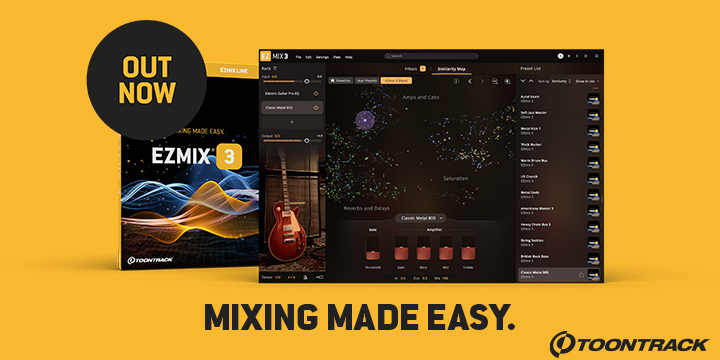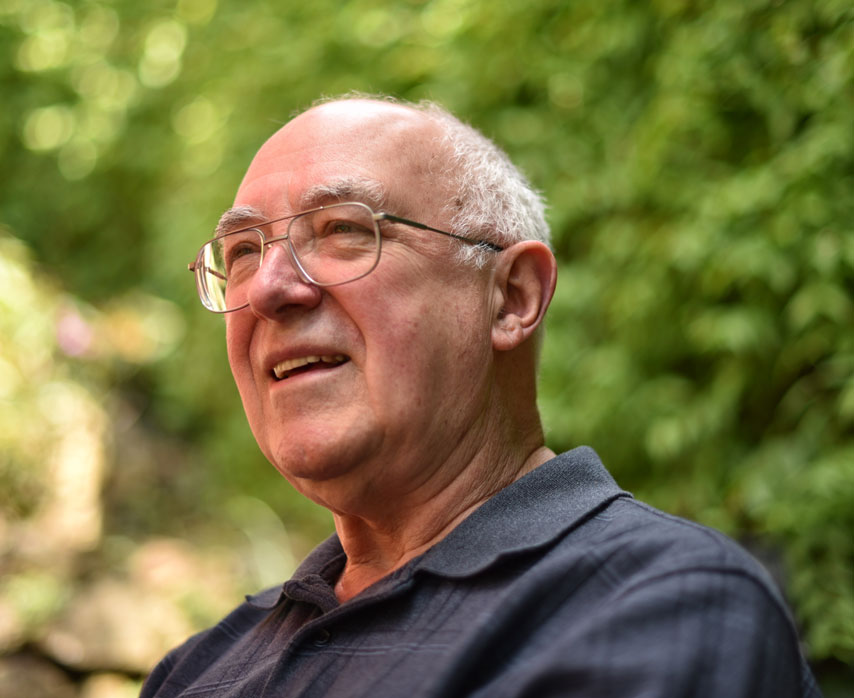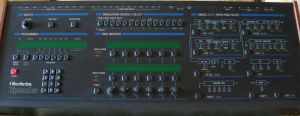Tom Oberheim has had a quite a career. Shortly after inventing the portable Phase Shifter he founded Oberheim Electronics in 1969, one of the first synthesizer and music technology companies from the 80's. In addition to many great products, Oberheim Electronics' spawned engineers like Dave Rossum and Marcus Ryle who have achieved fame and fortune with their own companies.
The collaboration between Tom and Dave Smith has produced the OB6, a very cool new/old product that combines Tom's experience and sonic judgment with Dave's own experience in hardware and new generation electrical and mechanical design expertise. They have a lot in common that goes beyond their creativity and design skills, having both started companies in the late 70s that produced some of the first commercially available synthesizers and sequencers, and both having their first businesses ultimately fail and then be reinvented. But, more on that in Part 2.
Tom was kind enough to sit down with me at the home of Roger and Ingrid Linn. As I got into talking to Tom it became clear that not only had he done more things in the industry than I had known about, but also possesses a clear recollection of the details. This is Part 1.
Let's start with your background.
I was destined to be an electrical engineer from third grade. Built my first radio, and did all kinds of stuff in junior high. Never had any doubt in my mind what I was going to do. I never had any idea that there was anything else but electrical engineering. And this was back in the hometown of Manhattan, Kansas, which is the site of Kansas State University, and I started there right out of high school.
My family had no money, so I couldn't participate in all the fun stuff. So I left Kansas State in Manhattan and went to Wichita. The plan was to make money so I could go back to college and really be a fraternity guy, play bridge in the afternoon, that kind of stuff. One day one of my older friends said, "Tom, a couple of us are going to move to California. Do you want to come?" Well, I was a real jazz aficionado then and I had read in DownBeat magazine that there was this club in Hermosa Beach (Los Angeles) called the Lighthouse that had a policy "No Cover, No Minimum." I thought, "You mean I can just walk in and hear Bud Shank and all of these jazz people?" That sounded great, so off I went. I ended up in Van Nuys, California on July 25, 1956 with ten bucks in my pocket.
And no job..?
I got a job the first day. Lockheed was getting started at the Van Nuys airport. The missile division was brand new, and I got a job at the photo lab. The photo lab was making printed circuit boards, because it's a photographic process.
And one day in 1956, I saw an ad in the LA Times for a draftsman trainee at National Cash Register in El Segundo. I thought, "Well I've had a semester drafting and I hate the Lockheed job." So I went down there and got the job, and it turned out it was the computer division of National Cash Register. They had bought a little computer company that made a drum vacuum tube computer, and they were getting into the computer business. When I got there it was heaven. You had to learn everything on your own, because there weren't any books on computers in those days. Although IBM was right on their heels, they were the first to have a transistorized computer.
When did you make your first musical instrument?
I knew I had to get a degree, so I started at UCLA in the fall of '57 to get a degree in Physics. The degree, required that I take either art or music or philosophy. So I took bonehead music appreciation, and it was like, wow, this is so cool. In fact the teacher was also teaching the music appreciation class for the sorority girls and the football players, so I asked, "Can I take some more classes from you?" He said, "Well, learn a little piano, and what harmony is about." So I got a junior high harmony book, and discovered that I had a natural ear.
So started spending most my time at UCLA in the music department. I started singing, and ultimately worked myself up into a group called the Gregg Smith Singers. We did all kinds of wild 20th century music. I was recording with a group that Igor Stravinsky himself conducted.
Wow! You were actually conducted by Igor Stravinsky?
Yup. And I met a bunch of musicians along the way. One day this gal came to me that was in a group called the United States of America, that was formed at UCLA. There was an engineer who had built them a ring modulator. She said, "Well when the group folded, the guy took his ring modulator. We need a ring modulator." I said, "Don't know what that is." So I went up to the engineering library at UCLA and I looked through the books and eventually discovered an obscure article written by a guy named Harold Bode, who worked with Bob Moog, and from that I learned how you could use that in music.
And they were using the ring modulator because they were doing electronic chorale music?
Yea, electronic music is part of what they did. So in 1967 I built a couple of three ring modulators. I built one for the trumpet player/composer Don Ellis. He was a very close friend and he was doing a lot of electronics. Then one day in early 1969, I got a phone call from this person who said, "I'm Leonard Rosenman and I'd like to use your ring modulator in this movie I'm doing the score for." It was Beneath the Planet of the Apes. So I took my ring modulator and I amplified the piano, and at the break, four or five of the orchestra people said, "What is this? Can I buy one?" And that's how I started.
And what came next?
At that time I was also friends with some young people that were children of the music industry. One gal's name was Wendy Waldman, and she was the daughter of Steiner, a big time movie composer. Another was Andrew Gold, whose father was Ernest Gold. They had just got a Beatles' album and on this album, George Harrison is playing through a Leslie speaker. And they were like, wow, this is a big deal. I thought, man, I should make something that does that.
So I borrowed a Hammond organ from a friend, but I couldn't really understand what was going on with the Leslie, because it's fairly complex. But I did come across a circuit called a phase shift circuit, and I thought, well that doesn't solve the Hammond organ/Leslie thing, but it sounds pretty cool. So I actually invented the first phase shifter that was available for musicians. It's called the Maestro Phase Shifter.
And the problem you were originally trying to solve was the Leslie's being so big and heavy to move.
Yea, (chuckles) my efforts at simulating Leslie came to naught, but for my phase shifter, I came upon this idea where you could change the speed of the oscillator so it'll change slower, like a Leslie does. And people thought that was cool. In fact Keith Barr (founder of MXR) thought it was so cool he brought out the Phase 90 about a year and a half later. (Laughs)
I sold about 100,000 of the Phase Shifters, and I was looking for ways to expand, so at a NAMM Show I went to the ARP booth and met David Friend. I said, "David, how would you like me as an ARP dealer for LA?" He was hesitant, but I persisted and he finally agreed. Because I had met so many musicians selling my ring modulators and phase shifters, I had a big Rolodex I could take advantage of. I sold a bunch of ARP 2600s, and that's how I first got into synthesizers.
So, after all this computer digital logic for eleven years, I decided to make a digital sequencer. I started selling the DS-2—that's what I called this sequencer—and that led to the first Synthesizer Expansion Module (SEM). I had Dave Rossum (founder of EMU) design the full-blown voice control oscillator for that.
And then, one day Norlin called up and canceled all of their orders, for the phase shifters and some other pedals I'd done. I thought about it for a few days, and said, "Well, what if I took four SEMs and licensed EMU's digital scanning keyboard and made a Four Voice." So that's what I did.
And that was all self contained. I remember there was a pretty big case.
Everything was in these tolex-covered cases for $4,000. I took it to the NAMM Show in June of '75. I remember Henry Goldrich (Manny's Music NYC) telling me: "$4,000? There's nothing in my store that sells for more than $1,000." Those are the days when a Les Paul was $800. But I stuck it out.
In those days I was really good friends with a guy named Steven St Croix (Mix Magazine columnist) and one day he said, "Do you want to go down and meet Stevie Wonder in the studio where he's working? Oh, and by the way, bring your 4-Voice." So we went into this studio on Vine Street in Hollywood and he played it and said, "Can I buy this one?" And of course this was crude, wire wrap, but he wanted it. I found out at the NAMM show a year ago, one of his handlers said, "Oh, we've still got that."
I don't remember just how it went from there, but before long it was being bought by guys like Joe Zawinul and Herbie Hancock...
The great Joe Zawinul
So how did you make the jump between building a wire wrap? —because so many people can build a prototype, but making the jump to producing a lot of them, can be much harder.
Well, I'd been a hardware engineer in computers for eleven years, so I knew all about circuit boards and circuit design and whatever, so that was just a natural thing. It just turned out that the one I took to Stevie's recording session was what I had working. I hadn't done the production unit yet.
Do you have any recollections that you can share about the development of MIDI?
Several of our products had computer interfaces going way back. When MIDI came out I appreciated the value of it, but it got a bum rap at Oberheim because there was a bit of "not invented here" (NIH) going on. But by the time we were starting to do the Xpander, it was obvious MIDI was going to have an effect. So we just went from one end to the other. I remember we had a several day mini conference at Oberheim, talking about the specs of the Xpander. So I think when it came out, it had the most complex MIDI that was on the market at the time. So we transitioned from where we were bad mouthing it to where we totally took it in.
I remember because I had the Xpander and couldn't use the MIDI on it right away because I was using your DSX sequencer, and the only way to interface was through the Gates and CVs.
MIDI had proven itself. I think, though Dave Smith might disagree, it took about two years before it really started to become where everyone was going to use it.
Read Part 2: The Phoenix Rises











 Other Related News
Other Related News